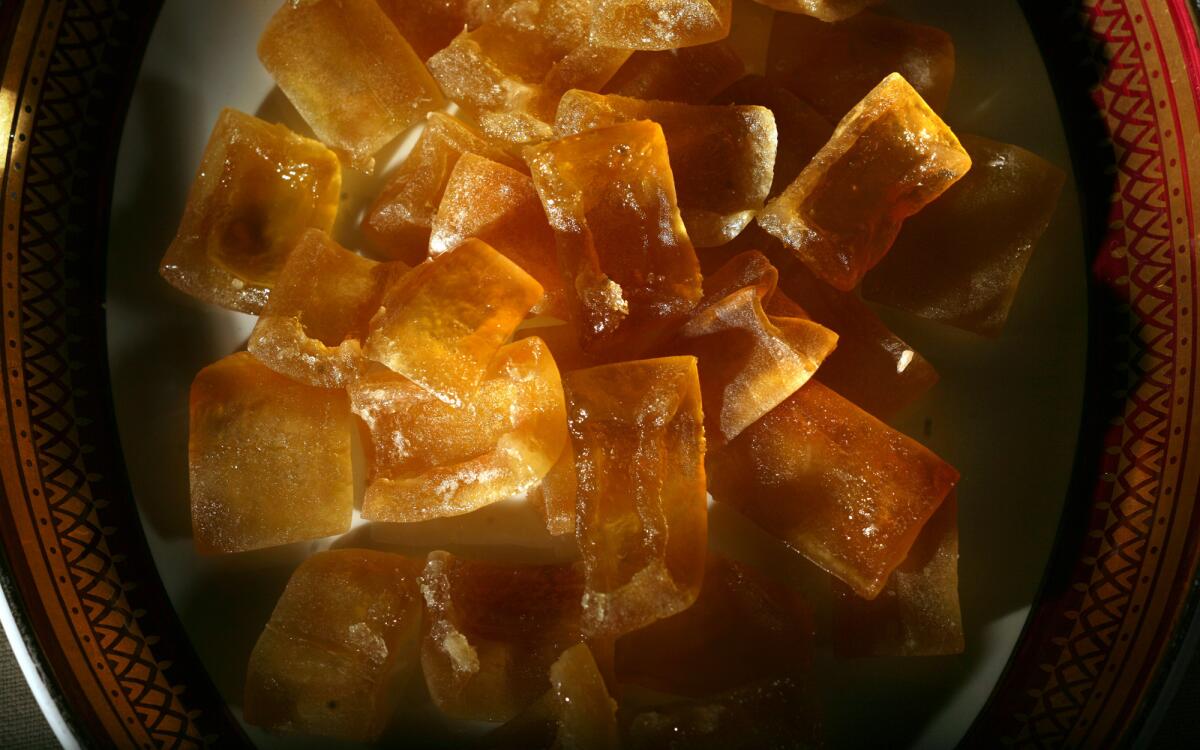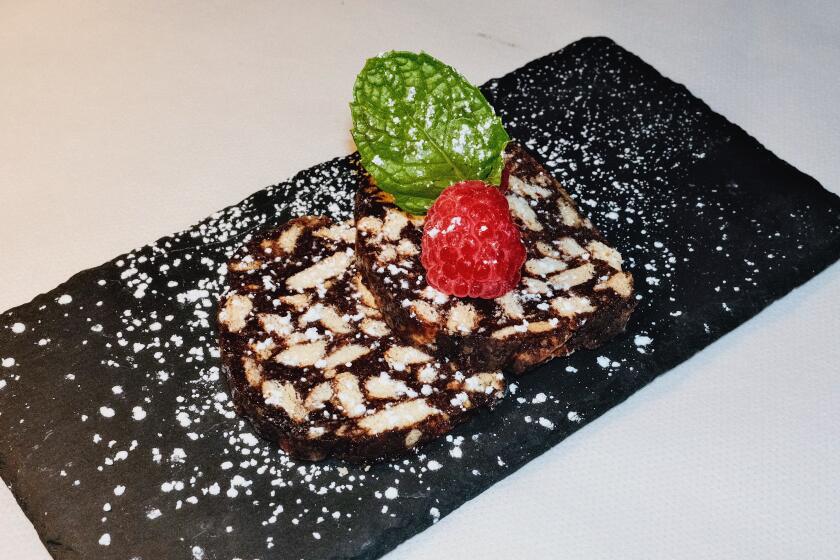Watermelon preserve

- Share via
Golden baked pastries drizzled with syrup served with rich clotted cream, crumbly homemade halvah with roasted pine nuts, baklava with a cheese filling served hot, custards sprinkled with rose water and ground nuts, strings of walnuts coated in grape molasses. Turkish sweets and desserts range from familiar syrup-soaked pastries to exotic asure, made of wheat berries, pulses and a cornucopia of dried fruits. Every one is delicious. But they’re also more than that.
In Turkey, sugar and sweet foods symbolize happiness and goodwill, and no special occasion is complete without sweets and candies. This is especially true of Ramadan, when desserts and candies are an essential part of every meal and a symbol of hospitality to visitors. The three-day Ramadan feast after the monthlong fast became so closely identified with sweets that since the 18th century, it has been popularly known as the Seker Bayrami, or Sugar Feast.
In Islamic tradition, sweet foods were instilled with religious symbolism, as shown by two oral traditions of the Prophet Muhammad that decorated the walls of Turkish confectionery shops in past centuries: “The love of sweets springs from faith” and “True believers are sweet.”
The monthlong Ramadan fast lasts from dawn to dusk, when nothing may be drunk or eaten. Relatives and friends are invited for the evening meal known as iftar, at which the fast is broken. A second, light meal called sahur is eaten just before dawn when the fast begins, and this usually includes a custard.
During Ramadan, a drummer walks the streets in every neighborhood, banging out virtuoso rhythms to wake up people in time for sahur. Until the early 20th century, as the month drew to an end, the drummers would stand outside the houses entertaining the inhabitants with poems as a polite way of asking for tips.
Until World War I, it was customary for rich people to keep open house during Ramadan. Anyone who turned up at the door was shown to one of scores of tables all over the house and sat down to eat his or her fill. For the hosts, this was an expensive obligation, and some families had to sell off valuables to pay for their lavish Ramadan hospitality. Consequently, Ramadan was the best time for antique collectors to find bargains, and visiting antique stalls was a popular pastime during the hours of fasting.
The iftar meal is divided into two stages. It begins with numerous appetizers and soup, then continues with the meal proper. The appetizers include all kinds of delicacies, depending on the locality, particularly pastirma (cured beef), cheeses of various sorts, olives, salads, dried dates, fruit preserves and fresh fruit. People usually break the fast with water first, then a date or an olive.
Baklava’s history
All kinds of sweets are served at iftar, but Ramadan is unthinkable without baklava and gullac, a pudding made of thin crepes soaked in sweetened milk or syrup flavored with rose water and stuffed or layered with ground nuts. Until a few years ago it was impossible to obtain gullac wafers at any time of year except Ramadan, but nowadays some grocery stores in large cities stock them year round. Packets of gullac tied with colored raffia appear in Ottoman period cartoons relating to Ramadan.
Eating baklava during Ramadan is a tradition that goes back to the 15th century, recorded in Ottoman palace documents. Baklava made with saffron was served at the hospice founded by Sultan Bayezid II around the 16th century in the city of Amasya.
Most famous of the Ramadan traditions relating to baklava was the Baklava Procession, which took place annually on the 15th of Ramadan. Hundreds of trays of baklava were prepared, one for every 10 janizaries -- the elite palace guards. They were baked in the palace kitchens, tied in cloths to protect them from dust and arrayed in the Second Court.
The first tray was presented to the sultan, who was an honorary member of the 1st Janizary Company. Then two janizaries from each squad would step forward by turn, pick up a tray and suspend it by the knotted cloth on a pole they carried on their shoulders. When all the trays had been collected, the janizary companies, each led by their officers and standard-bearer, would march out of the palace back to their barracks. The next day, the empty copper trays and cloths were returned to the palace kitchens.
In later years, however, after the janizaries became infamous for the abuses and arrogance that led to their replacement by a new modernized army in 1826, they stopped returning the trays and cloths, claiming that they had eaten those too. Until the Janizary Corps was liquidated in 1826, one and a half months after the last Baklava Procession, this event remained a popular annual spectacle.
Bootleg sweets
Ramadan ends with the Seker Bayram, when relatives, friends and neighbors visit one another and serve sweets such as baklava and candies such as Turkish delight, sugared almonds and akide (boiled sugar drops). From the 16th century, akide was the sweet of choice at all kinds of religious and social festivities, including Ramadan. Demand rose to such an extent that the guild confectioners could no longer produce akide in sufficient quantities. There was a rash of bootleg production, and sugar prices soared, leading to a clampdown on nonguild confectioners in 1582.
Wealthy women sent baskets of candies to their friends, midwife, children’s teachers and former servants who had left to marry. Visitors were offered small pieces of mastic-flavored rahat-i hulkum (Turkish delight), marzipan and musk-flavored akide sweets on decorated silver trays. The government distributed candies to soldiers and orphans.
So Ramadan is indeed both a fast and a feast. It falls in summer, with its long days and high temperatures, so going thirsty for more than 12 hours is not easy. So when iftar time comes around, glasses of cool water and laden tables are more than welcome. People spend more time with family and friends around the table, nibbling at the array of sweets after the main meal is over and conversing into the night.
As they say in Turkey, “eat sweet, talk sweet.”
Priscilla Mary Isin is a writer on Turkish culinary history. She has lived in Turkey since 1973. She has written a book on the history of Turkish confectionery.
Fill a stainless steel or other nonreactive pot or container (do not use aluminum) with 12 cups of water. Stir the pickling lime into the water. Set aside for 1 to 2 hours, then pour the clear water into another nonreactive pot or container (discard the lime at the bottom). Set aside for another hour to give the remaining lime time to settle, then pour off the clear liquid into another nonreactive container, discarding the lime at the bottom.
Cut the watermelon rind into finger-sized chunks or pieces and toss them into the strained water. Set aside to soak for 3 to 4 hours, then drain and rinse thoroughly several times.
Meanwhile, in a medium, heavy-bottom pot, combine the sugar with the remaining 2 cups of water. Heat over medium-high heat until the sugar dissolves and the mixture comes to a boil. When the mixture begins to thicken, add the lemon juice and bring to a boil again. Carefully add the watermelon chunks. Simmer over medium heat until the pieces take on an amber shade and are mostly transparent, about 45 minutes. Remove from heat. Strain the watermelon pieces using a slotted spoon and set aside to cool on a sheet of parchment paper.
Get our Cooking newsletter
Get a taste of Los Angeles — and the world — with recipes and kitchen tricks from the L.A. Times’ Cooking newsletter.
You may occasionally receive promotional content from the Los Angeles Times.















